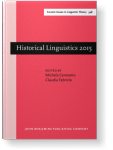Chapter 15
Early Indo-European dialects and innovations of aspect systems
Dialectal grouping of early Indo-European is usually reconstructed by listing phonological, grammatical, and lexical similarities, without asking the question of whether these properties constitute typologically coherent sets that may have determined further developments. Moreover, the dialectal differentiation of early Indo-European is viewed as a rather linear process, whereas a closer look at the properties suggests intermediate discontinuities and alliances with longer-lasting effects. This paper addresses these issues generally and specifically in the realm of aspect and tense systems. The case in point is particularly aspect, often addressed in discussions, but so far never systematically investigated for the early period. The analysis presented here reveals the following essential paths in the development of aspect systems: by extension of spatial preverb semantics into the temporal sphere, by extension of light-verb semantics into the temporal sphere, or by extension of the combined aspectotemporal system. The essential division is between spatial semantics developing into temporal semantics and tense developing into a marker of aspect. The paper discusses the development paths, typological constellations, and the evidence from aspect systems on the early differentiation of Indo-European, which crosscuts the hitherto reconstructed groupings based on single properties and areal divisions.
Article outline
- 1.Introduction
- 2.Constitutive elements of Indo-European aspect systems
- 3.Conclusion
-
Notes
-
Abbreviations
-
Sources
-
References
